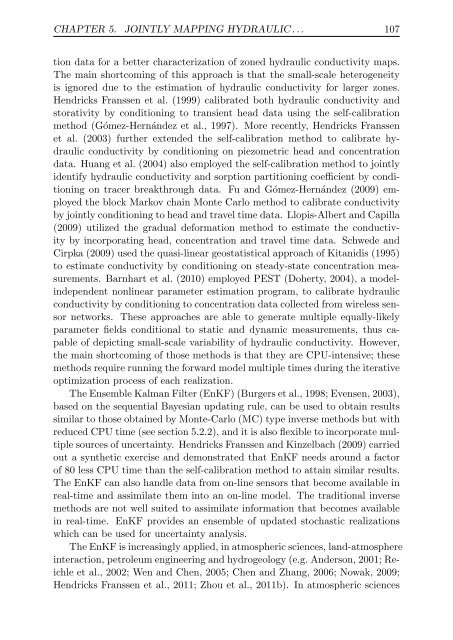Upscaling and Inverse Modeling of Groundwater Flow and Mass ...
Upscaling and Inverse Modeling of Groundwater Flow and Mass ...
Upscaling and Inverse Modeling of Groundwater Flow and Mass ...
You also want an ePaper? Increase the reach of your titles
YUMPU automatically turns print PDFs into web optimized ePapers that Google loves.
CHAPTER 5. JOINTLY MAPPING HYDRAULIC . . . 107<br />
tion data for a better characterization <strong>of</strong> zoned hydraulic conductivity maps.<br />
The main shortcoming <strong>of</strong> this approach is that the small-scale heterogeneity<br />
is ignored due to the estimation <strong>of</strong> hydraulic conductivity for larger zones.<br />
Hendricks Franssen et al. (1999) calibrated both hydraulic conductivity <strong>and</strong><br />
storativity by conditioning to transient head data using the self-calibration<br />
method (Gómez-Hernández et al., 1997). More recently, Hendricks Franssen<br />
et al. (2003) further extended the self-calibration method to calibrate hydraulic<br />
conductivity by conditioning on piezometric head <strong>and</strong> concentration<br />
data. Huang et al. (2004) also employed the self-calibration method to jointly<br />
identify hydraulic conductivity <strong>and</strong> sorption partitioning coefficient by conditioning<br />
on tracer breakthrough data. Fu <strong>and</strong> Gómez-Hernández (2009) employed<br />
the block Markov chain Monte Carlo method to calibrate conductivity<br />
by jointly conditioning to head <strong>and</strong> travel time data. Llopis-Albert <strong>and</strong> Capilla<br />
(2009) utilized the gradual deformation method to estimate the conductivity<br />
by incorporating head, concentration <strong>and</strong> travel time data. Schwede <strong>and</strong><br />
Cirpka (2009) used the quasi-linear geostatistical approach <strong>of</strong> Kitanidis (1995)<br />
to estimate conductivity by conditioning on steady-state concentration measurements.<br />
Barnhart et al. (2010) employed PEST (Doherty, 2004), a modelindependent<br />
nonlinear parameter estimation program, to calibrate hydraulic<br />
conductivity by conditioning to concentration data collected from wireless sensor<br />
networks. These approaches are able to generate multiple equally-likely<br />
parameter fields conditional to static <strong>and</strong> dynamic measurements, thus capable<br />
<strong>of</strong> depicting small-scale variability <strong>of</strong> hydraulic conductivity. However,<br />
the main shortcoming <strong>of</strong> those methods is that they are CPU-intensive; these<br />
methods require running the forward model multiple times during the iterative<br />
optimization process <strong>of</strong> each realization.<br />
The Ensemble Kalman Filter (EnKF) (Burgers et al., 1998; Evensen, 2003),<br />
based on the sequential Bayesian updating rule, can be used to obtain results<br />
similar to those obtained by Monte-Carlo (MC) type inverse methods but with<br />
reduced CPU time (see section 5.2.2), <strong>and</strong> it is also flexible to incorporate multiple<br />
sources <strong>of</strong> uncertainty. Hendricks Franssen <strong>and</strong> Kinzelbach (2009) carried<br />
out a synthetic exercise <strong>and</strong> demonstrated that EnKF needs around a factor<br />
<strong>of</strong> 80 less CPU time than the self-calibration method to attain similar results.<br />
The EnKF can also h<strong>and</strong>le data from on-line sensors that become available in<br />
real-time <strong>and</strong> assimilate them into an on-line model. The traditional inverse<br />
methods are not well suited to assimilate information that becomes available<br />
in real-time. EnKF provides an ensemble <strong>of</strong> updated stochastic realizations<br />
which can be used for uncertainty analysis.<br />
The EnKF is increasingly applied, in atmospheric sciences, l<strong>and</strong>-atmosphere<br />
interaction, petroleum engineering <strong>and</strong> hydrogeology (e.g. Anderson, 2001; Reichle<br />
et al., 2002; Wen <strong>and</strong> Chen, 2005; Chen <strong>and</strong> Zhang, 2006; Nowak, 2009;<br />
Hendricks Franssen et al., 2011; Zhou et al., 2011b). In atmospheric sciences


